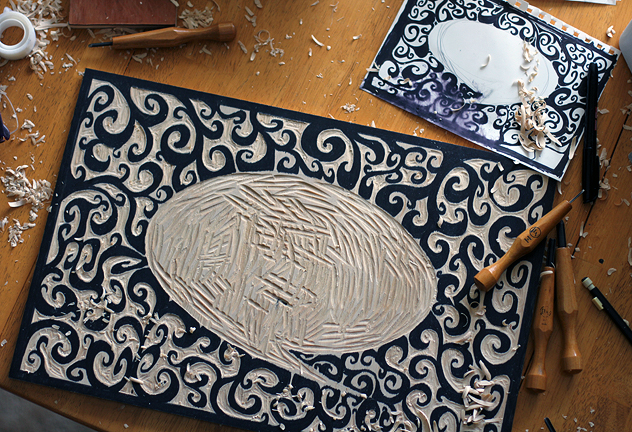Printmaking
Printmaking, in its simplest form, is the process of transferring ink from a matrix onto a surface by applying pressure. The plate can be re-inked and the process repeated to create multiples, each of which is considered an original print.
Prints can be separated into four general categories depending on how the ink interacts with the print matrix: Relief, Intaglio, Planographic or Stencil processes
Relief prints:
The printing ink sits on the peaks of a relief plate and prints only the high elements of the plate. Woodcut, linocut and wood engravings are examples of this process.
Linocut
A linoleum relief print, also called a linocut, is created by using knives and gouges to cut away areas of a linoleum plate. When the surface of the linoleum is inked with a roller, the ink transfers only to the high points of the plate and does not come in contact with the areas that have been removed by cutting. The plate is then printed by placing paper over the inked up plate and applying pressure either by hand or with the use of a press. I use a manual etching press for most of my linoleum work. The pressure transfers the inky image to the paper--in mirror image. The white areas that you see in my prints are the areas that have been cut away from the plate, and the black areas are the ink that has been transferred from the uncut areas of the plate. While making a linocut is a relatively simple process, it is also a counterintuitive one.
Why work in linocut?
Linocut is a hard-edged graphic medium that intrigues me with its on or off, black or white, high contrast there or not-there nature. I have attempted to push its potential for subtlety and tease out the appearance of greys using only black or white and a myriad of handmade marks. There is a certain futility in this effort that is an important part of the process for me. These works record every cut made in the plate, including every error and every victory. The history of the piece is recorded in a trail of printed proofs. Within my portrait-based pieces, the entire process both parallels and attests to the futility of knowing someone fully, if we can ever even claim to know them well, despite our time and best efforts.
Intaglio prints:
With intaglio prints, ink is pushed into the recesses of a plate that has been etched or gouged to create a relief surface. Any excess ink is wiped away from the plate's high points so the ink is pulled out of the recesses and transferred to paper when the plate is printed under pressure. Examples are: etchings, aquatints, engravings, mezzotints, collographs.
Etching
Edinburgh Printmaker's video: Etching at Edinburgh Printmakers demonstrates several intaglio processes including etching, engraving and drypoint.
Planographic prints:
Planographic prints are printed from a perfectly flat matrix rather than one that is incised with peaks and valleys. Examples include stone lithographs, plate lithographs and monotypes.
Lithography
Lithography is a magical process based on the premise that oil and water repel one another. If you are curious to to see how the process works, take a look at this video produced by MoMA.
Stencil based prints:
The ink passes through the matrix when a stencil process is used for making prints. Screenprinting and pochoir printing are examples.

